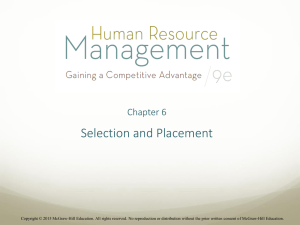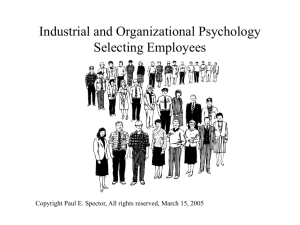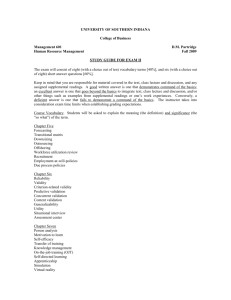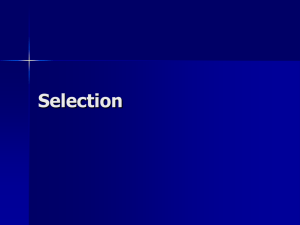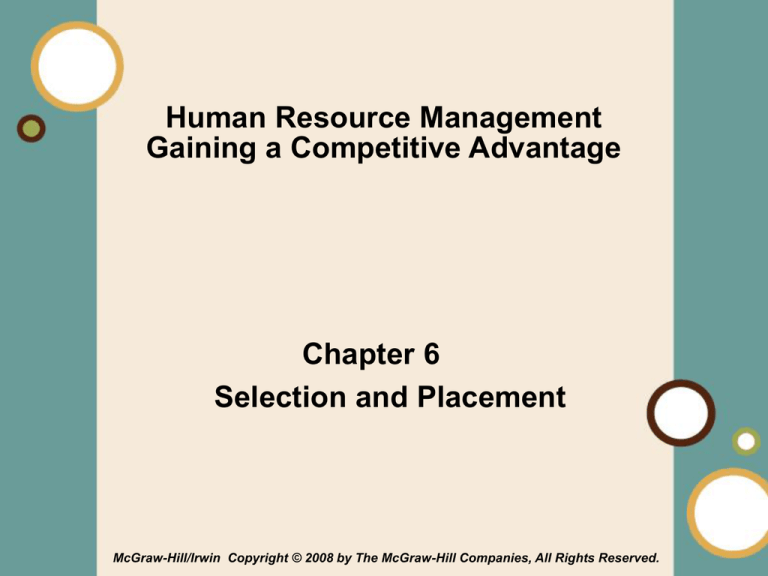
Human Resource Management
Gaining a Competitive Advantage
Chapter 6
Selection and Placement
McGraw-Hill/Irwin Copyright © 2008 by The McGraw-Hill Companies, All Rights Reserved.
1-1
Learning Objectives
After reading this chapter, you should be able to:
• Establish the basic scientific properties of personnel
selection methods, including reliability, validity, and
generalizability.
• Discuss how the particular characteristics of a job,
organization, or applicant affect the utility of any test.
• Describe the government’s role in personnel selection
decisions, particularly in the areas of constitutional law,
federal laws, executive orders, and judicial precedent.
• List the common methods used in selecting human
resources.
• Describe the degree to which each of the common
methods used in selecting human resources meets the
demands of reliability, validity, generalizability, utility, and
legality.
6-2
Selection Method Standards for
Evaluation Purposes
Reliability
Validity
Generalizability
Utility
Legality
6-3
Reliability
• Reliability is the degree to which a measure of
physical or cognitive abilities, or traits, is free
from random error.
• The correlation coefficient is a measure of the
degree to which two sets of numbers are
related.
– A perfect positive relationship equals +1.0
– A perfect negative relationship equals - 1.0
• Knowing how scores on the measure at one
time relate to scores on the same measure at
another time refers to test-retest reliability.
6-4
Validity
• Validity is the extent to which a performance
measure assesses all the relevant—and only
the relevant—aspects of job performance.
• Criterion-related validation is a method of
establishing the validity of a personnel selection
method by showing a substantial correlation
between test scores and job-performance
scores. The types include:
– Predictive validation
– Concurrent validation
6-5
Criterion-Related Validity
Predictive
Test
Applicants
Measure
Performance
of those Hired
TIME
Concurrent
Test
Existing
Employees
Measure
their
Performance
TIME
6-6
Content Validation
• Content validation is a test-validation
strategy performed by demonstrating
that the items, questions, or problems
posed by a test are a representative
sample of the kinds of situations or
problems that occur on the job.
– Best for small samples
– Content validity is achieved primarily through
a process of expert judgment
6-7
Generalizability
• Generalizability is the degree to which
the validity of a selection method
established in one context extends to
other contexts.
• Three contexts include:
– different situations
– different samples of people
– different time periods
6-8
Utility
• Utility is the degree to
which the information
provided by selection
methods enhances the
effectiveness of selecting
personnel in organizations.
• It is impacted by reliability,
validity, and generalizability.
6-9
Legality
• All selection methods must conform to
existing laws and legal precedents.
• Three acts have formed the basis for a
majority of the suits filed by job
applicants:
– Civil Rights Act of 1964 and 1991
– Age Discrimination in Employment Act of
1967
– Americans with Disabilities Act of 1991
6-10
Civil Rights Act of 1991
• This act protects individuals from
discrimination based on race, color, sex,
religion, and national origin.
• The 1991 act differs from the 1964 act in
three different areas:
– It establishes employers' explicit obligation to
establish neutral-appearing selection
method.
– Allows a jury to decide punitive damages.
– It explicitly prohibits the granting of
preferential treatment to minority groups.
6-11
Age Discrimination in
Employment Act
• Covers individuals who
are over the age of 40.
• There is no protection for
younger workers.
• This act outlaws almost
all “mandatory
retirement” programs.
6-12
Americans with Disabilities Act
• Protects individuals with physical or
mental disabilities (or with a history of
the same).
• Reasonable accommodations are
required by the organization to allow the
disabled to perform essential functions of
the job.
– An employer need not make
accommodations that cause undue hardship.
• Restrictions on preemployment inquiries.
6-13
Executive Orders
• Executive Order 11246 parallels the Civil
Rights Act of 1964 but goes beyond it by:
– requiring affirmative action to hire qualified
protected group applicants, and
– allowing the government to suspend all
business with a contractor while an
investigation is going on.
• The Office of Federal Contract
Compliance and Procedures (OFCCP)
issues guidelines and helps companies
comply.
6-14
Types of Selection Methods
Interviews
Honesty Tests
and Drug Tests
Work Samples
Personality
Inventories
References and
Biographical Data
HR
JOBS
Physical Ability
Tests
Cognitive Ability Tests
6-15
Interviews
• Selection interviews are defined as a dialogue
initiated by one or more persons to gather
information and evaluate the qualifications of an
applicant for employment.
• The utility of an interview can be increased by the
following suggestions:
– Interviews should be structured, standardized, and
focused on goals oriented to skills and behaviors that
are observable.
– Interviewers should plan to come out of each
interview with a quantitative rating.
– Interviewers should also have a structured note-taking
system that will aid recall when it comes to satisfying
the ratings.
6-16
Situational Interview
• A situational interview
confronts applicants on
specific issues,
questions, or problems
that are likely to arise on
the job.
• These interviews consist
of:
– experience-based
questions
– future-oriented questions
6-17
Other Selection Methods
• References, Biographical data, and
Application Blanks gather background
information on candidates.
• Physical ability tests are relevant for
predicting not only job performance but
occupational injuries and disabilities.
Types of physical ability tests include:
–
–
–
–
–
muscular tension, power, and endurance
cardiovascular endurance
flexibility
balance
coordination
6-18
Other Selection Methods
• A cognitive ability test differentiates
individuals based on their mental rather
than physical capacities. Abilities most
commonly assessed are:
– verbal comprehension
– quantitative ability
– reasoning ability
• Personality inventories categorize
individuals by their personality
characteristics.
• Work samples simulate the job in
miniaturized form.
6-19
Honesty Tests
• The Polygraph Act of 1988
banned the use of polygraph
tests for private companies
except pharmaceutical and
security guard suppliers.
• Paper-and-pencil honesty
testing attempts to assess the
likelihood that employees will
steal.
– Since these tests are new, there
is little evidence on their
effectiveness.
6-20
Drug Tests
• Drug-use tests tend to be reliable and valid.
• The major controversies of drug tests includes:
– Is it an invasion of privacy
– Is it an unreasonable search and seizure
– Is it a violation of due process
• Tests should be administered systematically to all
applicants applying for the same job.
• Testing is likely to be more defensible when there
are safety hazards associated with the failure to
perform.
• Test results should be reported to the applicant, who
should have an avenue to appeal.
6-21

